This is an essay about the American sculptor David Smith (1906–1965). Its main subject is the relation within his work between two fundamental aspects of sculpture, making and meaning. Every sculpture that takes material form relies on these linked attributes, but few sculptors, either before Smith or after, have found them so full of potential, so open to reinvention and reworking. Even fewer were so promptly able to understand that industrial labor could open the way to a new formal territory, while also offering a means to put sculptural communication on terms with its material world. In his workshop metal and the meanings it conveyed came close to being one and the same.
***
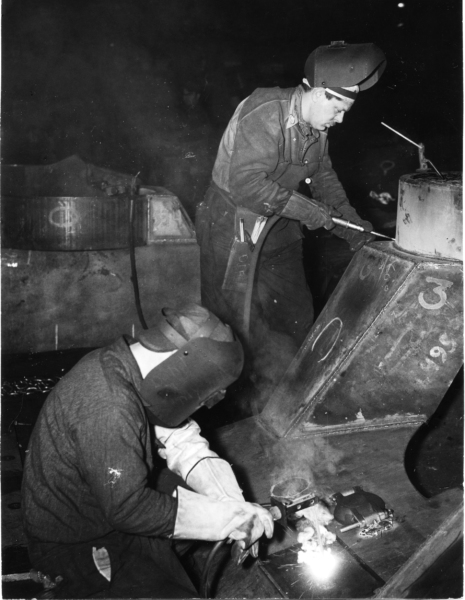
To think about the semantics of Smith’s work is above all to consider the labor that went into it, in the process informing how it was made. In this regard Smith’s story is well known. He famously welded steel, but also bent, pierced and cut it, lifted and placed it, often singlehandedly; in other words, he worked steel and iron directly, rather than turning to assistants to do the heavy lifting his art required.1 Yet despite Smith’s commitment to the bodily labor of making, the materials and procedures he used were then, and still remain, those of the military-industrial complex as famously defined by President Dwight D. Eisenhower in 1961.2 The artist, then aged 55, was only four years from his death. He learned to weld in the 1930s while employed by the auto industry, working for Studebaker, and a decade later made use of those same skills on a Schenectady (NY) assembly line, where he was as crucial as every other human cog in the effort to manufacture tanks for use in World War II.
From these experiences Smith unquestionably learned the fundamentals of welding, but when it came to the production of sculpture he needed to widen his skills. Put simply, he had to discover nothing less than how to work abstractly, using iron and steel. A good portion of his material was repurposed from its origins in batch lots of scrap the artist purchased by volume, which means he bought it on the cheap. Even now there remains an implicit question: who is to say that the shapes of boilers and water tanks are inherently less promising for use in sculpture than any other material sculptors deploy? The same issue hadn’t lost its resonance when, after Smith’s accidental death in 1965, his unused supply of scrap metal was shipped to England, where Anthony Caro would use it himself.3
Even this brief outline of Smith’s life as an artist is enough to suggest why the trajectory of his sculpture had its origins in the early 1940s, with Smith in his role as a war worker—a welder on a munitions factory assembly line. Improbably enough we have a photograph which shows him at work in Schenectady, welding a tank at the American Locomotive Plant in about 1942 (fig. 1). Of the two men pictured, he is the one shown standing, his protective visor lifted to accommodate the unknown photographer then touring the factory on the alert for evocative shots. The depiction of war work—what it looked like, who did it—was common fodder in the illustrated magazines of the moment, but for those with a stake in the matter, this particular photograph also brings home Smith’s grasp of a skill invaluable to the above-mentioned “complex.”4 These are the talents that explain why the workers employed in Schenectady’s factories, Smith included, were exempt from military service. As “key workers” (a category tragically again made current by the Covid-19 pandemic) their lives and labor were more valuable at home than on the battlefield. In combat neither life nor death was solely a function of skill. On the home front, by contrast, what mattered was the ability to transfer technologies developed making cars in peacetime to the manufacture of tanks and planes in World War II. One can only savor the irony. War or peace, the necessary skills were the same. With the cessation of hostilities, the factories were quickly returned to normal, with automobiles the product of choice. As for Smith, he was demobilized in 1945 having massively enlarged his command of the very tools and skills he would rely on to sculpt. As he proudly put it, he left the factory “having been rated by army ordnance as a 1st class armor plate welder.”5
Initially it was not the world of the wartime factory alone that directed Smith towards constructed sculpture. The drama of that narrative makes it easy to forget that well before the war, starting in the early 1930s, he began to consider himself an artist and to soak up whatever he could discover about the European avant-garde. He knew the welded metal constructions of Pablo Picasso and Julio González from the pages of Cahiers d’Art, works that led him in 1933 to the purchase of an air reduction oxyacetylene torch—the same one he was still using around 1950, when he wrote an account of his life.6 As he put it, his skill as a welder gave him “… a chance to make sculpture in a tradition I was already rooted in.”7 It was an opportunity few artists shared, not even Picasso, who relied on González, his friend and fellow Barcelonan, to realize his work.
To read González’s story is to be struck by its points of difference and overlap with Smith’s. On the one hand both men owed their skills to quite specific circumstances of family, nation and class. The Spaniard learned to weld not only because mastery of the skill was part of his family’s tradition, but also because ironwork had a long history as a feature of the architecture of his native city. Ornamental metal work is still found in Barcelona’s surviving nineteenth-century buildings, particularly as part of their doors and window grills. Many speak the language of Antoni Gaudí.
This is not to say that familial or local traditions necessarily offer the best means to explain how sculptors work. Did González turn to welding simply because he was born into a family of successful metal-smiths, in a city where forging metal was a valued skill? Or do the implications of his decision seem less personal when we recall that in the early twentieth century, industrialized technologies, including industrialized warfare, were beginning to pull the old craft traditions apart? During the First World War, González preceded Smith in mastering oxyacetylene welding; he did so while working on the Renault assembly line making armaments for use by the French.8 In this same context, Picasso’s chosen media when it came to constructed sculpture seem ironically freighted. Think of the harmlessness of the paper, glue and pins he used to mock up almost theatrically disposable versions of that most elegantly crafted of all national symbols, the Spanish guitar. And even before his guitars, construction as a practice first entered the sculptural frame via Picasso’s papiers collées, pasted paper collages that explored the possibilities of a purely additive syntax. It was a good decade before the artist understood enough about this new terrain to seek González’s help in using metal and torch in place of paper and glue. That change waited until late 1930, when together, the two Spaniards constructed the tour de force that is Picasso’s very clever and very sexist Head of a Woman. Consider his use of tightly coiled springs as hair and colanders as a head. In Spanish, the idiom for “head like a sieve” is “la cabeza como un colador.”
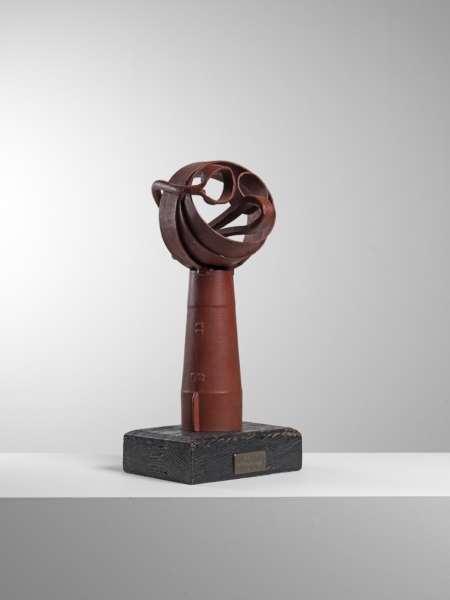
By 1930 Smith, aged 23, was not only looking closely at the work coming out of Europe, but also doing his best to keep up. Within just a few years, he produced Agricola Head, 1933, a welded steel work with a Latin title translated as Agricultural Head or Agrarian Head—either will do (fig. 2).9 In contrast to Picasso’s piece, Smith’s bust looks male, not least thanks to its painted surface and sketchy features—to my eye they seem to conjure drain pipes and flower pots, plus the ruddy complexion that speaks of outdoor work.
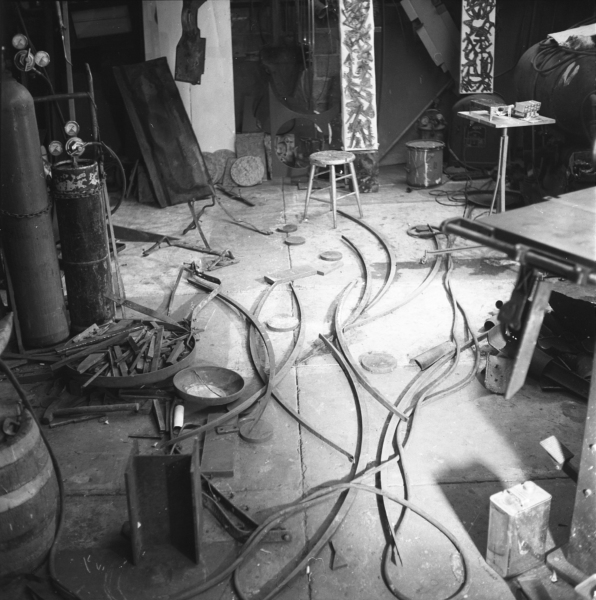
Smith himself, however, was an indoor worker, a machine age artist, as his workshop setup amply informs us (fig. 3).10 There he ruled, exercising full command of the cutters, stamps, and presses with which his own workshop overflowed. There, in Bolton Landing, his view of his art—his vision of it—came into its own. This is the vision I have termed “sculpture as sign.” Which leads of course to the necessity of bearing down on the question of what Smith wished his viewer to see in his work. The question is speculative, but there is enough evidence to suggest a preliminary answer. For a start, there’s little doubt that he was quite conscious of a real need to shape the view of his work. Simply consider how he set out his sculpture in the fields around his studio (fig. 4); it’s as if each work is a point of reference: a coordinate on an unseen grid, a grid made up of permanent concrete bases on which each was fixed. The scheme made it possible to keep to the same parameters, the same arrangement, winter and summer. Clearly this is useful when you are pondering the three-dimensional presence a sculpture commands. Given his solitary working conditions, such careful stocktaking wasn’t all that easy to do. Yet we can be sure he gave it some thought, and then turned to the grid.
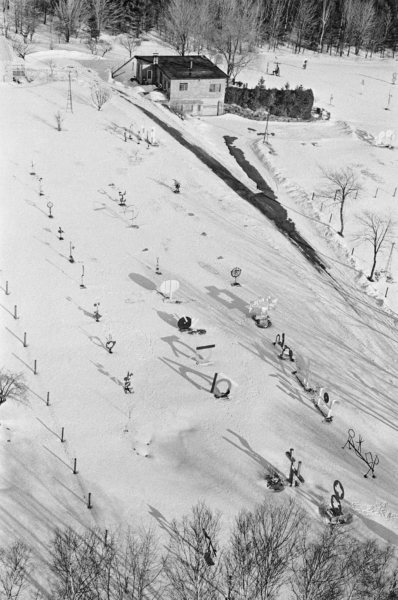
Why? Remember that every grid is a relational system, which in its ideal form exits in two dimensions. In other words, grids are abstractions, placeless and flat. To really take hold of Smith’s sculpture, it’s crucial to keep both ideas—flatness and placelessness—in mind. He seems to have done so, not only in arranging his sculpture, but in producing it. Flatness was a function of his process, part of how he worked. And for the most part, he worked alone. Hence his reply to an interviewer in 1961: “I can’t use studio assistants any more than Mondrian could have used assistants… it is defensive in a certain way because its contradictory to the progression of this age. We are among the few people left who are making the object from start to finish.”11
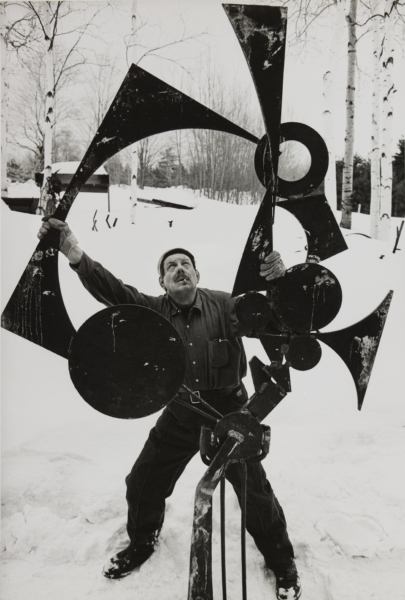
So on the one hand, there is the virile drama conveyed in Dan Budnik’s great photo of his effort to position Bolton-Voltri 10 (fig. 5), and then, on the other, the considerably more prosaic—yet also defensive—studio practice—defensive because anti-modern, defensive because he worked alone. This is why he welded his sculptures only after arranging and rearranging their pieces on the studio floor. Perhaps the outcome was inevitable. Much of his sculpture—certainly the large-scale work—seems as concerned with surface as it is with volume; which is to say it is as interested in planarity as it is in depth.
The flatness of Smith’s sculpture has its inevitable limits, yet those limits are clearly the precise conditions that the artist aimed to discover, to map. This is what is happening on the occasions when the steel components of a possible composition were laid out on paper or canvas, rather than directly on the floor (fig. 6). Then, using a “wily stencil technique,” as one critic called it, Smith used a spray gun, in the process creating absences—dematerialized sculptures which bring to mind the great phrase famously invoked by William Hazlitt to mock the vaporous effects achieved by the English painter J. M. W. Turner: they are “pictures of nothing, and very like.”12
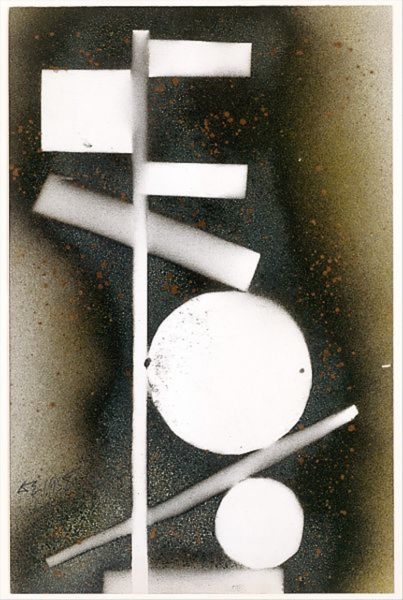
For Smith making a sculpture was very much something—something heavy and physically demanding. Thus his tactic of working with cut steel shapes arranged on the floor. There each could be toed, rather than lifted into various positions, until the composition looked right. Only then were the pieces lifted, and, bottom to top, securely welded into place. Last came one final round of decisions, the one that gave the sculpture its overall presence, its look. Notoriously, the surfaces of some Smiths were painted, while others, made of iron, display a matte and rusty patina.13 Another commanding group of steel pieces, the Cubi, present brilliantly flashing scribbles ground into the surface of the metal (fig. 7). As the range of his work declares, the sculptor had clearly articulated views about how to confront the character of his medium. To cite him directly, “The metal itself possesses little art history. What associations it possesses are those of this century: Power, structure, movement, progress, suspension, brutality.”14 Does it need insisting that Smith’s commitment to these martial, even militant themes speaks to the artist’s evident disinterest in working with wood? His work had little to do with traditional modes of making, as sustained throughout the long histories of craft.
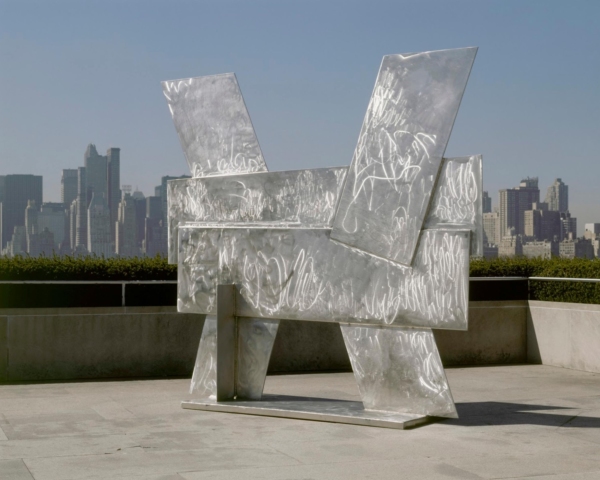
Quite a list—and one not to be dismissed. On the contrary, yet we clearly need to take account of Smith’s laconic comment about his quasi-calligraphic treatment of surfaces: “I depend a great deal on the reflective power of light.”15 Indeed he did. To look at his surfaces in the sunlight is to see the traces of the sander, sometimes held stably, sometimes skipping wildly, making a radiant scribble. These surface marks have a Kilroy bravado—an illegible mark of self and presence, a sign volatilized by the rays of the sun. It plays across the surfaces of his great series, the Cubi, and sizzled even more splendidly on the great steel construction that is Becca, 1965, particularly as photographed sited on the rooftop terrace of the Metropolitan Museum of Art, in New York.16
At this concluding point in an essay that given its brevity is itself inevitably something of a “wily stencil,” the moment has come to restate its aims. The goal is to assess the implications of Smith’s approach to sculpture as both an ethical and bodily fact. As always in twentieth-century practices of sculpture, “body” and “ethic” are closely aligned. This is because sculpture front-loads the involvement of labor, which leads inescapably to essential questions. Who conceives of the sculpture? Who does the physical work required to produce it? How much are they paid? Do the ratios between labor and recompense seem to make sense? It is too seldom that questions like these are asked to make common cause with the aesthetic scrutiny customarily addressed to works of art.
Yet of course it will not do to romanticize the reality of labor, the sheer bodily burden of physical work. That burden notwithstanding, the amount of energy Smith was willing to invest in his sculpture was sufficient to generate the forms that structured his art. Made on the flat, his every metal construction emphasizes shape and surface, as well as the emptiness between the varied components of which each piece is composed. Such synthetic structures are the antithesis to traditionally modelled shapes in which curve follows curve, beginning follows end.
Yet neither sort of surface, modelled or planar, is simply the site of showy effects. On the contrary, they are the means that sculpture has at its disposal to testify to its physical existence: its surface is something rather like a primal memory, an indelible ontogeny to be emphasized, not polished away. At the same time, the scribble and skip of the sander brings Smith’s work as close as it comes to weightlessness—or might we say transcendence? None of his constructions is ever truly virtualized, truly vaporized, but still, at serendipitous moments, their surfaces spark and crackle with light. At such moments, the sculpture’s body is banished, replaced by a scribble, a cipher, a flash. As for the sculptor, at least for a moment, he too has been left behind. Meanwhile, back in the studio, yet another sculpture is nudged into shape on a much-stained concrete floor.
Notes
This is an essay about the American sculptor David Smith (1906–1965). Its main subject is the relation within his work between two fundamental aspects of sculpture, making and meaning. Every sculpture that takes material form relies on these linked attributes, but few sculptors, either before Smith or after, have found them so full of potential, so open to reinvention and reworking. Even fewer were so promptly able to understand that industrial labor could open the way to a new formal territory, while also offering a means to put sculptural communication on terms with its material world. In his workshop metal and the meanings it conveyed came close to being one and the same.
***

To think about the semantics of Smith’s work is above all to consider the labor that went into it, in the process informing how it was made. In this regard Smith’s story is well known. He famously welded steel, but also bent, pierced and cut it, lifted and placed it, often singlehandedly; in other words, he worked steel and iron directly, rather than turning to assistants to do the heavy lifting his art required.1 Yet despite Smith’s commitment to the bodily labor of making, the materials and procedures he used were then, and still remain, those of the military-industrial complex as famously defined by President Dwight D. Eisenhower in 1961.2 The artist, then aged 55, was only four years from his death. He learned to weld in the 1930s while employed by the auto industry, working for Studebaker, and a decade later made use of those same skills on a Schenectady (NY) assembly line, where he was as crucial as every other human cog in the effort to manufacture tanks for use in World War II.
From these experiences Smith unquestionably learned the fundamentals of welding, but when it came to the production of sculpture he needed to widen his skills. Put simply, he had to discover nothing less than how to work abstractly, using iron and steel. A good portion of his material was repurposed from its origins in batch lots of scrap the artist purchased by volume, which means he bought it on the cheap. Even now there remains an implicit question: who is to say that the shapes of boilers and water tanks are inherently less promising for use in sculpture than any other material sculptors deploy? The same issue hadn’t lost its resonance when, after Smith’s accidental death in 1965, his unused supply of scrap metal was shipped to England, where Anthony Caro would use it himself.3
Even this brief outline of Smith’s life as an artist is enough to suggest why the trajectory of his sculpture had its origins in the early 1940s, with Smith in his role as a war worker—a welder on a munitions factory assembly line. Improbably enough we have a photograph which shows him at work in Schenectady, welding a tank at the American Locomotive Plant in about 1942 (fig. 1). Of the two men pictured, he is the one shown standing, his protective visor lifted to accommodate the unknown photographer then touring the factory on the alert for evocative shots. The depiction of war work—what it looked like, who did it—was common fodder in the illustrated magazines of the moment, but for those with a stake in the matter, this particular photograph also brings home Smith’s grasp of a skill invaluable to the above-mentioned “complex.”4 These are the talents that explain why the workers employed in Schenectady’s factories, Smith included, were exempt from military service. As “key workers” (a category tragically again made current by the Covid-19 pandemic) their lives and labor were more valuable at home than on the battlefield. In combat neither life nor death was solely a function of skill. On the home front, by contrast, what mattered was the ability to transfer technologies developed making cars in peacetime to the manufacture of tanks and planes in World War II. One can only savor the irony. War or peace, the necessary skills were the same. With the cessation of hostilities, the factories were quickly returned to normal, with automobiles the product of choice. As for Smith, he was demobilized in 1945 having massively enlarged his command of the very tools and skills he would rely on to sculpt. As he proudly put it, he left the factory “having been rated by army ordnance as a 1st class armor plate welder.”5
Initially it was not the world of the wartime factory alone that directed Smith towards constructed sculpture. The drama of that narrative makes it easy to forget that well before the war, starting in the early 1930s, he began to consider himself an artist and to soak up whatever he could discover about the European avant-garde. He knew the welded metal constructions of Pablo Picasso and Julio González from the pages of Cahiers d’Art, works that led him in 1933 to the purchase of an air reduction oxyacetylene torch—the same one he was still using around 1950, when he wrote an account of his life.6 As he put it, his skill as a welder gave him “… a chance to make sculpture in a tradition I was already rooted in.”7 It was an opportunity few artists shared, not even Picasso, who relied on González, his friend and fellow Barcelonan, to realize his work.
To read González’s story is to be struck by its points of difference and overlap with Smith’s. On the one hand both men owed their skills to quite specific circumstances of family, nation and class. The Spaniard learned to weld not only because mastery of the skill was part of his family’s tradition, but also because ironwork had a long history as a feature of the architecture of his native city. Ornamental metal work is still found in Barcelona’s surviving nineteenth-century buildings, particularly as part of their doors and window grills. Many speak the language of Antoni Gaudí.
This is not to say that familial or local traditions necessarily offer the best means to explain how sculptors work. Did González turn to welding simply because he was born into a family of successful metal-smiths, in a city where forging metal was a valued skill? Or do the implications of his decision seem less personal when we recall that in the early twentieth century, industrialized technologies, including industrialized warfare, were beginning to pull the old craft traditions apart? During the First World War, González preceded Smith in mastering oxyacetylene welding; he did so while working on the Renault assembly line making armaments for use by the French.8 In this same context, Picasso’s chosen media when it came to constructed sculpture seem ironically freighted. Think of the harmlessness of the paper, glue and pins he used to mock up almost theatrically disposable versions of that most elegantly crafted of all national symbols, the Spanish guitar. And even before his guitars, construction as a practice first entered the sculptural frame via Picasso’s papiers collées, pasted paper collages that explored the possibilities of a purely additive syntax. It was a good decade before the artist understood enough about this new terrain to seek González’s help in using metal and torch in place of paper and glue. That change waited until late 1930, when together, the two Spaniards constructed the tour de force that is Picasso’s very clever and very sexist Head of a Woman. Consider his use of tightly coiled springs as hair and colanders as a head. In Spanish, the idiom for “head like a sieve” is “la cabeza como un colador.”

By 1930 Smith, aged 23, was not only looking closely at the work coming out of Europe, but also doing his best to keep up. Within just a few years, he produced Agricola Head, 1933, a welded steel work with a Latin title translated as Agricultural Head or Agrarian Head—either will do (fig. 2).9 In contrast to Picasso’s piece, Smith’s bust looks male, not least thanks to its painted surface and sketchy features—to my eye they seem to conjure drain pipes and flower pots, plus the ruddy complexion that speaks of outdoor work.

Smith himself, however, was an indoor worker, a machine age artist, as his workshop setup amply informs us (fig. 3).10 There he ruled, exercising full command of the cutters, stamps, and presses with which his own workshop overflowed. There, in Bolton Landing, his view of his art—his vision of it—came into its own. This is the vision I have termed “sculpture as sign.” Which leads of course to the necessity of bearing down on the question of what Smith wished his viewer to see in his work. The question is speculative, but there is enough evidence to suggest a preliminary answer. For a start, there’s little doubt that he was quite conscious of a real need to shape the view of his work. Simply consider how he set out his sculpture in the fields around his studio (fig. 4); it’s as if each work is a point of reference: a coordinate on an unseen grid, a grid made up of permanent concrete bases on which each was fixed. The scheme made it possible to keep to the same parameters, the same arrangement, winter and summer. Clearly this is useful when you are pondering the three-dimensional presence a sculpture commands. Given his solitary working conditions, such careful stocktaking wasn’t all that easy to do. Yet we can be sure he gave it some thought, and then turned to the grid.

Why? Remember that every grid is a relational system, which in its ideal form exits in two dimensions. In other words, grids are abstractions, placeless and flat. To really take hold of Smith’s sculpture, it’s crucial to keep both ideas—flatness and placelessness—in mind. He seems to have done so, not only in arranging his sculpture, but in producing it. Flatness was a function of his process, part of how he worked. And for the most part, he worked alone. Hence his reply to an interviewer in 1961: “I can’t use studio assistants any more than Mondrian could have used assistants… it is defensive in a certain way because its contradictory to the progression of this age. We are among the few people left who are making the object from start to finish.”11

So on the one hand, there is the virile drama conveyed in Dan Budnik’s great photo of his effort to position Bolton-Voltri 10 (fig. 5), and then, on the other, the considerably more prosaic—yet also defensive—studio practice—defensive because anti-modern, defensive because he worked alone. This is why he welded his sculptures only after arranging and rearranging their pieces on the studio floor. Perhaps the outcome was inevitable. Much of his sculpture—certainly the large-scale work—seems as concerned with surface as it is with volume; which is to say it is as interested in planarity as it is in depth.
The flatness of Smith’s sculpture has its inevitable limits, yet those limits are clearly the precise conditions that the artist aimed to discover, to map. This is what is happening on the occasions when the steel components of a possible composition were laid out on paper or canvas, rather than directly on the floor (fig. 6). Then, using a “wily stencil technique,” as one critic called it, Smith used a spray gun, in the process creating absences—dematerialized sculptures which bring to mind the great phrase famously invoked by William Hazlitt to mock the vaporous effects achieved by the English painter J. M. W. Turner: they are “pictures of nothing, and very like.”12

For Smith making a sculpture was very much something—something heavy and physically demanding. Thus his tactic of working with cut steel shapes arranged on the floor. There each could be toed, rather than lifted into various positions, until the composition looked right. Only then were the pieces lifted, and, bottom to top, securely welded into place. Last came one final round of decisions, the one that gave the sculpture its overall presence, its look. Notoriously, the surfaces of some Smiths were painted, while others, made of iron, display a matte and rusty patina.13 Another commanding group of steel pieces, the Cubi, present brilliantly flashing scribbles ground into the surface of the metal (fig. 7). As the range of his work declares, the sculptor had clearly articulated views about how to confront the character of his medium. To cite him directly, “The metal itself possesses little art history. What associations it possesses are those of this century: Power, structure, movement, progress, suspension, brutality.”14 Does it need insisting that Smith’s commitment to these martial, even militant themes speaks to the artist’s evident disinterest in working with wood? His work had little to do with traditional modes of making, as sustained throughout the long histories of craft.

Quite a list—and one not to be dismissed. On the contrary, yet we clearly need to take account of Smith’s laconic comment about his quasi-calligraphic treatment of surfaces: “I depend a great deal on the reflective power of light.”15 Indeed he did. To look at his surfaces in the sunlight is to see the traces of the sander, sometimes held stably, sometimes skipping wildly, making a radiant scribble. These surface marks have a Kilroy bravado—an illegible mark of self and presence, a sign volatilized by the rays of the sun. It plays across the surfaces of his great series, the Cubi, and sizzled even more splendidly on the great steel construction that is Becca, 1965, particularly as photographed sited on the rooftop terrace of the Metropolitan Museum of Art, in New York.16
At this concluding point in an essay that given its brevity is itself inevitably something of a “wily stencil,” the moment has come to restate its aims. The goal is to assess the implications of Smith’s approach to sculpture as both an ethical and bodily fact. As always in twentieth-century practices of sculpture, “body” and “ethic” are closely aligned. This is because sculpture front-loads the involvement of labor, which leads inescapably to essential questions. Who conceives of the sculpture? Who does the physical work required to produce it? How much are they paid? Do the ratios between labor and recompense seem to make sense? It is too seldom that questions like these are asked to make common cause with the aesthetic scrutiny customarily addressed to works of art.
Yet of course it will not do to romanticize the reality of labor, the sheer bodily burden of physical work. That burden notwithstanding, the amount of energy Smith was willing to invest in his sculpture was sufficient to generate the forms that structured his art. Made on the flat, his every metal construction emphasizes shape and surface, as well as the emptiness between the varied components of which each piece is composed. Such synthetic structures are the antithesis to traditionally modelled shapes in which curve follows curve, beginning follows end.
Yet neither sort of surface, modelled or planar, is simply the site of showy effects. On the contrary, they are the means that sculpture has at its disposal to testify to its physical existence: its surface is something rather like a primal memory, an indelible ontogeny to be emphasized, not polished away. At the same time, the scribble and skip of the sander brings Smith’s work as close as it comes to weightlessness—or might we say transcendence? None of his constructions is ever truly virtualized, truly vaporized, but still, at serendipitous moments, their surfaces spark and crackle with light. At such moments, the sculpture’s body is banished, replaced by a scribble, a cipher, a flash. As for the sculptor, at least for a moment, he too has been left behind. Meanwhile, back in the studio, yet another sculpture is nudged into shape on a much-stained concrete floor.
Notes

nonsite.org is an online, open access, peer-reviewed quarterly journal of scholarship in the arts and humanities. nonsite.org is affiliated with Emory College of Arts and Sciences.